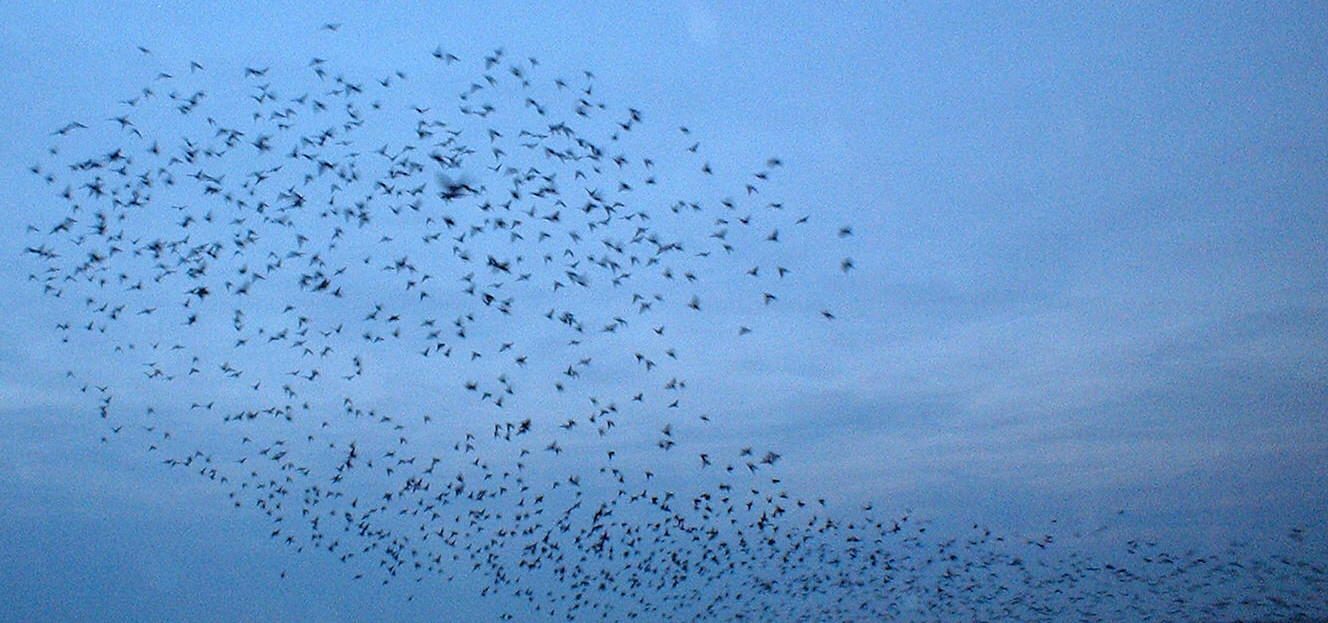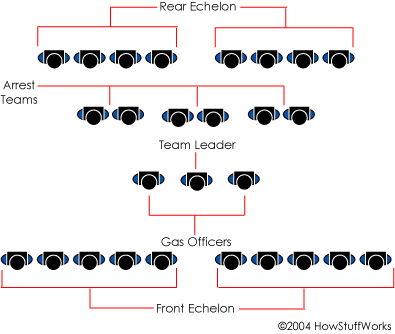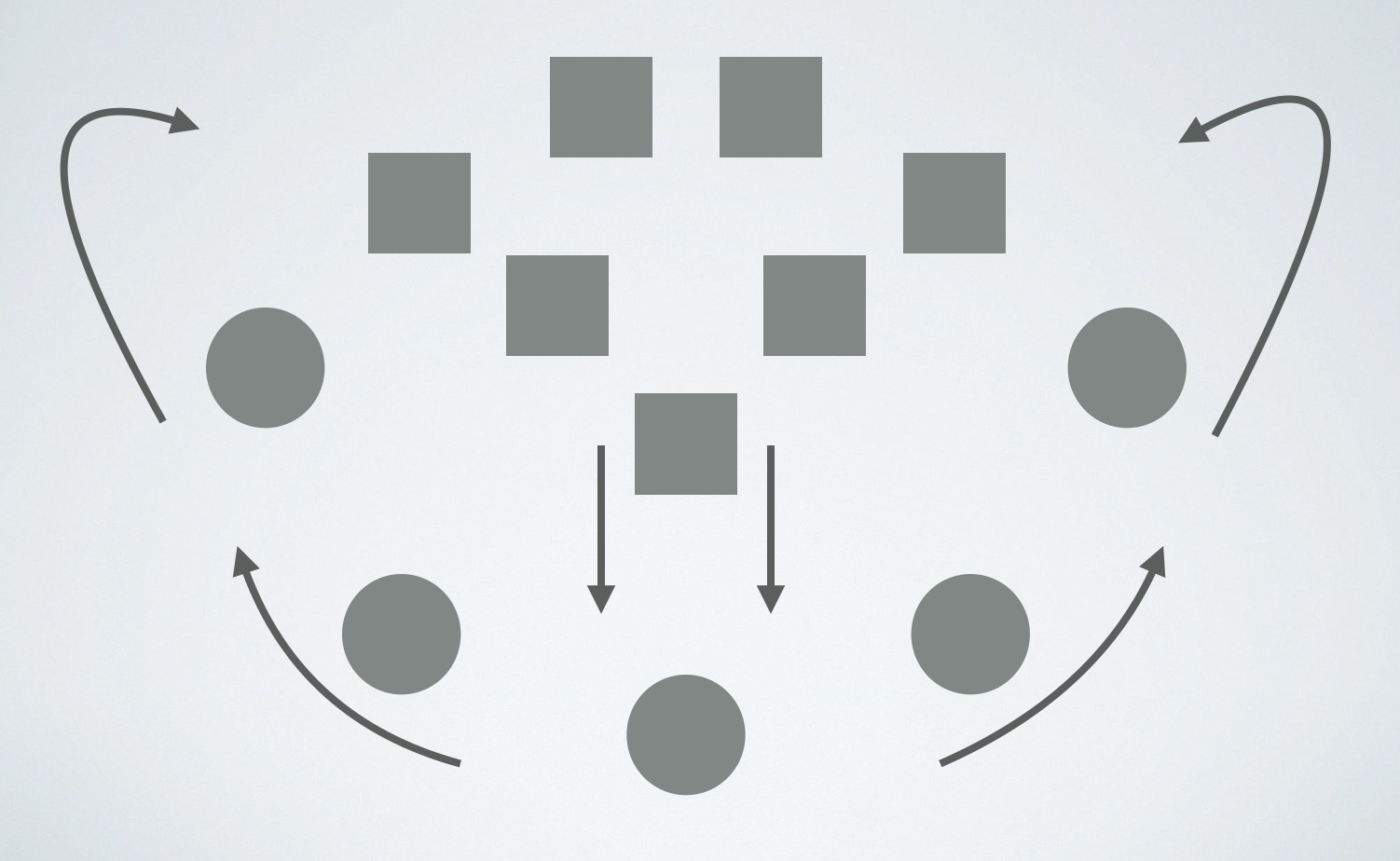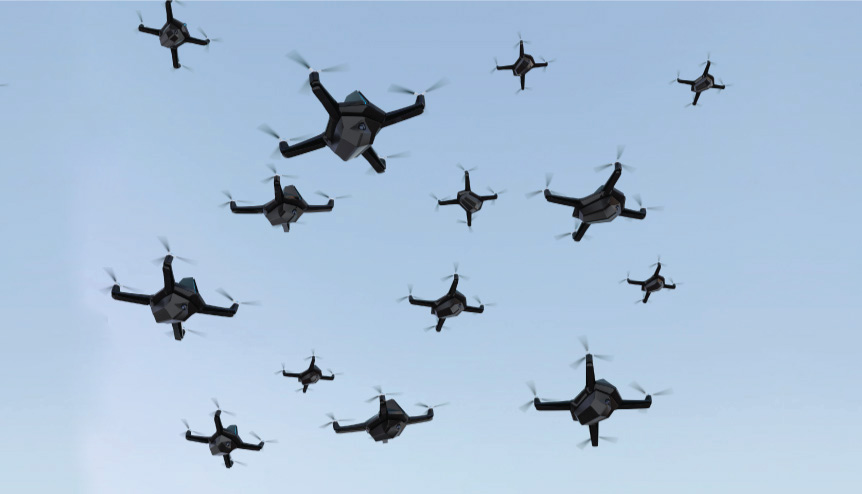Swarm Formations and Choreographies
Swarm formations are very common to find in nature. Bird flocks, fish schools, insect communities work together towards a common goal. A species that may be weak on its own becomes powerful as a result of forming a swarm. Many complex behaviors emerge, which seems like a sign of intelligence.
Interestingly enough, this emergent swarm intelligence is a result of each individual following a set of simple rules. It’s not that each individual in the group is trying to be smart or powerful. They are just doing their simple task and the group becomes smart and powerful as a result.

These same principles that can be observed in swarm dynamics can also be applied to physical movement and social formations. They can serve as an interesting basis for choreography, crowd dynamics, and a better understanding of protest dynamics and of anti-protest suppression techniques.
In fact, the police, military, and, since recently, rioters are using those same tactics and they are largely inspired by nature, so let us explore how it works.
How do Swarms Work?
If we look at a fish school, its dynamics may seem quite complex. They move around, create formations when they need to move in a certain direction, dissipate when there’s a danger or an obstacle, and, generally, seem to be very responsive to their environment and clever in seeking their goal (food).
This complexity is based on a few simple rules that every individual fish follows.
- repulsion: if it gets too close to another fish, it’s going to move away from it.
- attraction: if another fish is within the vicinity, they will move towards it,
- parallel orientation: if they came close, they will align and move in the same direction,
- food as the priority: when there is food, the fish behaves individualistically and will forget the rules 1 to 3. After the food is gone, it’s going to form a school again.
- foraging: Fish has to have energy, so it is always searching for food. Therefore, if no fish is within the vicinity (so no possibility to form a flock), the fish will move in a seemingly random fashion looking for nutrients. Interestingly, these foraging patterns often exhibit fractal chaotic dynamics, which means a lot of small random movements and a few, but a significant number of long-stretch jumps.

On the collective level, the result of each individual following the rules above is that
- fishes will usually organize themselves into flocks, eventually
- the flock will generally move in the same direction, directed by limitations in their environment
- when there is an obstacle the flock separates and comes together again.
- if the obstacle is too big, the flock will split.
As a result, the flock shows adaptive, fluid behavior. The reason it is adaptive and fluid, however, is not because the fish is trying to be fluid. Rather, it simply follows a very clear and simple logic from which the fluid complexity emerges.
This behavior can be tested using the simulation below made by Jesse Lee (see his website for the code and the explanation). Such simulations are usually called “boids” (the small elements floating around the screen). You can try adjusting the different parameters and see how the flock reacts. You can turn on “follow the mouse” and, in that case, your mouse cursor emulates the nutrients in space.
This sort of behavior is observed in many other species. Interestingly, it can also be found in brain neurons. There are theories that consciousness itself emerged as a result of neurons simply searching for food (see the work by Vergara, Jaramillo et al published in 2019). The idea is that as neurons need energy to work, they are randomly searching for the connections with other neurons as they get rewarded when there is an impulse going through them, so they stay alive and don’t die. Therefore, as a result, they start making complex formations, given the space and the energy limitations they have, creating interconnected clusters where each could be responsible for certain activities.
So even the human intelligence may be a result of a bunch of neurons looking for something to eat and randomly stumbling into intelligence as a result of their evolution.
Human Swarms: Military, Police, and Rioters
Humans have long been inspired by swarm formations. As it often happens military was the first to draw inspiration from it for their warfare operations. Swarm formations have been used for hundreds of years, ironically tested in hoarding animals, and during this time the military and the police have perfected their use of the swarming tactics.
Swarm-like formations, when used in attacks, have a different logic than the standard linear warfare.
For instance, in linear warfare, the focus is made on the gradual build-up and penetration (read a detailed study on warfare formations by our partners Nodus Labs).
Swarms, on the other hand, are pulsating and multiple. They appear and disappear at various places and time, orchestrating a collective strategy which will wear the other side down. They follow the principle of variability to the fullest extent not only in order to adapt and survive, but also to defeat the opponent.
RAND Corporation, which is a major provider of research to the US military, has distinguished between the cloud and vapor swarm formations (see their study on swarm tactics).
Cloud Swarms
Cloud swarms, which are similar to the fish schools described above, can be very effective in fighting in situations where the balance of power is on the other side or in unstable environments. These formations are often used by the special forces groups, for instance, in closed-quarter combat (CQC).
Closed-quarter combat or CQC is based on constant communication between the soldiers to avoid friendly fire. This is done by maintaining constant body contact, where each soldier will always be in touch with the other so that if one of them moves, the others will follow.
Police and anti-riot forces often use swarm tactics where a group of policemen (usually about 5 or 6) will grab each other and only move as a collective entity. This makes it very difficult to attack any one of them and gives them a power advantage when dealing with groups or individuals: that’s why they will usually extract only one person (usually a leader) from the crowd in order to attack this one person as a group and to be effective in their neutralization. When grabbing a person, police uses so-called star technique — which is a swarm attack formation where one person controls and protects the suspect’s head, the other four go for the limbs (one each).
Riot police also use what’s known as “kettling”: a group of protesters is surrounded by a circle and nobody can leave. Then the police can move the crowd to another location or use this formation to avoid the crowd breaking into the small formations forcing the police to disperse (in order to catch them) as well.

Another formation that’s used is called the Echelon Formation — the front is protecting, the second group is dissipating, the third is arresting, the rear echelon is used to replace them. They get out into the crowd, grab a protester, and suck them in behind the first echelon where the arrest ones are getting them.

This is very similar to the strategy used by the wolf packs: when they are walking along a path, they have an interesting strategy of self-alignment where the weaker and the older wolves go in the front, followed by an attack pack, closed by the leader. This may be an evolutionary strategy that emerged based on the survival instinct.
Another interesting strategy is called “feigned withdrawal”, which was used in the Battle of Manzikert in 1071, where the Turks pretended to retreat, then encircled and ambushed the pursuing Byzantines from all directions. A hundred years later, the Mongols called this the “Mangudai technique.” In this case, a swarm formation gives in to the incoming impulse first, assimilating the incoming impulse, but only in order to engulf and encircle the enemy and to destroy them from the outside.

Interestingly, when the rioters are also using the cloud swarm or linear tactics (e.g., staying as a group, walking in a line) this usually doesn’t help as the police tend to be more organized and have better means of coordination and coordination. The cloud swarming tactics demands the ability to exert high amounts of overwhelming power in a quick manner and will usually fail if the opposing side has a strong intention and the means to fulfill it.
Vapor Swarms
As a result, rioters have also adopted some tactics to counter that of police. For instance, the liquid metaphor is often used in many different countries (be like water). The idea is to not have one formation but to have many smaller ones emerging at different places at different moments of time (pulsating and temporary formations emerging at multiple different spots simultaneously). This does not give time to police to regroup (as they have to use bigger groups to overwhelm the protesters) and also allows the protesters to be more mobile in terms of their movement tactics and protest. These tactics were used in the Belarus protests in 2020 and in Hong Kong and allowed the protesters to wear down the police as it has limited resources and cannot always dispatch big groups of people to suppress the protest.
Military also use vapor swarms to a limited extent, especially in special operations, when there is a need to perform a covert and quick operation and to overwhelm an enemy who may have more resources. Police use this tactics to a certain extent when they send agents into the crowds who provoke escalation and draw attention to a certain part of the protest, which is then suppressed by a small group that arrives to retrieve the leader.
To counter the level of police’s organization, rioters often use additional self-organization measure, which includes supply chains (similar to the insects), task specialization (so that each group is focused on a specific aspect of work), covert communication (which cannot be intercepted and therefore anticipated). This helps them coordinate the efforts and to orchestrate the collective swarm action in response to the changing environment.
Swarm Choreography
Based on the information above we can come up with a few simple rules that could be used in designing a collective swarm movement, which could be used to design choreography. It could be applied in public spaces as a performative action or when leading large groups of people through a procession.
1) Adhesion.
In order to stay together each element of the swarm needs to follow the simple rules of repulsion / attraction / orientation. This way the swarm stays cohesive and mobile, and, as a result, becomes a collective liquid entity. This could be done using physical contact (like in CQC, always feeling the partner) or visual contact (1.5 – 2 meters like in the bird swarms). Then if one person is moving, the rest will follow. If somebody falls apart, they will quickly get to another swarm. This should be combined with a clear direction of where you actually want to move so that everybody knows the plan.
2) Multiple Formations.
Have several formations at play that emerge and recede, depending on the objective (e.g. retain the position, move to a new destination) — a star, a diamond, a moving “kettling” formation etc.
3) Vapor Swarming.
The swarms should have a degree of diversity, so they don’t always stay together as a group. Therefore a simple rule could be made that there should always be at least several groups that exist and nobody should be left alone for too long time. This will lead to cohesive but distinct groups, which can reform, but also stay together (“vapor swarm”) — what’s called non-linear, dispersed operation (NLDO) in the military jargon.
4) Occupy, Disrupt, Disperse, Repeat
This principle helps support the vapor swarming formation. The group never stays at one space for too long. It occupies it, performs its action, then disperses (joining the other groups or formations), and then a new constellation repeats the process.
5) Communication.
We can use our eyes and our bodies to communicate, but also the sound and various communication tools that can provide visual and haptic feedback. Additional tools could be used, such as laser pointers to indicate a direction, incense to indicate a direction or space, decoration, and protection: face masks, umbrellas, protection gear.
6) Variability
It is important to variate between the energies used in each swarm in its relation to the environment. They replicate the energies used by each individual (repulsion / attraction / orientation / foraging) but on the collective level:
Bounciness – relates to the Peng force – a combination of repulsion / attraction — the swarm can be adaptive and flexible in relation to the environment but it never gives in fully.
Orientation – Ji — to push forward, going with the flow,
Assimilation / Response – escalation/deescalation to provoke movement, giving in and responding (as the feigned withdrawal tactics described above above)
Foraging – searching for a new area — restructurization
8) Static and Mobile.
A swarm should combine the static parts that maintain operations and a certain position with the mobile units that are focused on capturing the disruptors (or pulsing the crowd for control)
9) Individual Rotation.
It is important that nobody stays alone for too long and that the leaders are rotated. This allows the swarm formation to be truly dispersed and makes it less susceptible to disruption.





